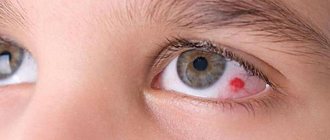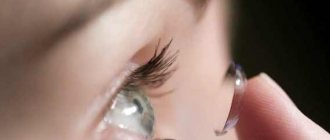Cold compresses
When can you use cold compresses?
Cold compresses on the eyes are used as a soothing remedy to relieve pain, itching and burning for:
- conjunctivitis;
- allergies;
- irritation from ultraviolet or bright light;
- thermal burn;
- chemical burn;
- irritation with chemicals (after swimming, exposure to tear gas, cutting onions, horseradish, etc.);
- bruises on the first day.
What should you do if your eyes become dry or irritated after swimming in the pool?
How to properly apply cold compresses?
To make a cold compress on your eyes at home you need:
- take a piece of clean cotton fabric, folded in 6-8 layers;
- wet with clean cold water;
- squeeze until the water stops flowing;
- apply to closed eyes;
- since the compress quickly warms up to body temperature, change the napkins or re-wet them every 2-3 minutes; [1]
- The total duration of the procedure can be about 1 hour.
Why do my eyelids itch?
Eye redness, flaking and itching cannot be ignored. After all, the symptoms that appear may indicate the development of various diseases.
Allergy
In an allergic reaction, redness and itching around the eyes are caused by irritants that have sensitizing properties:
- incorrectly selected hygiene and care products, decorative cosmetics,
- dust, wool, fluff and feathers,
- plant flowering products.
Usually, after eliminating contact with the sensitizing agent, redness, burning in the eyes and other unpleasant symptoms do not progress, but do not disappear very quickly. You should not use decorative cosmetics for two weeks; you must moisturize the skin under your eyes, ensure a comfortable indoor microclimate for your eyes, and ensure timely rest.
Medicines that a person is forced to take for treatment or to maintain health can act as an irritant that causes itching of the eyelids. In this case, the doctor should prescribe an analogue or select a different course of therapy.
Demodicosis
A disease caused by hair mites. They live in most people (about 95%) and do not cause discomfort until comfortable conditions for reproduction are created for them. Redness and itching on the eyelids are not caused by the hair mites themselves, but by their metabolic products. When parasites become active, symptoms appear:
- redness of the eyelids,
- itching, which intensifies in the evening,
- blurred vision,
- the formation of small ulcers on the mucous membrane,
- the appearance of foaming liquid and white deposits on the eyelashes,
- feeling of a speck under the eyelids,
- eyelash loss.
The disease requires immediate medical treatment because it is fraught with complications.
Blepharitis
This is an inflammation of the edges of the eyelids, the causes and treatment of which can only be determined by an ophthalmologist. Blepharitis can be a manifestation of some pathological process or an independent disease. Its initial stage can be determined by the main symptoms:
- redness in the corners of the eyes,
- swelling of the eyelids (they seem to swell),
- burning in bright light,
- the eyelids become covered with a thin crust (the skin below the eye often suffers).
Blepharitis is also characterized by peeling and itching, dry skin around the eyes, and loss of eyelashes.
Blepharitis is difficult to treat, so you need to be patient and follow all the ophthalmologist's recommendations.
Conjunctivitis
The disease is transmitted by contact from sick people or animals. The virus can “hide” in bedding and personal hygiene items. Most often, conjunctivitis occurs with a weakened immune system, long-term use of antibiotics, or during respiratory diseases. Microbes are favorable for the progression of the disease. It is enough to rub the skin around the eyes with dirty hands, and within a day itching and peeling of the eyelids will appear. Later, the whites of the eyes will turn red and pus will appear. This problem is relevant not only for children, but also for adults.
Barley
It can appear with colds, dental diseases, inflammation of the maxillary sinuses and ear canals. The first symptom is severe itching on the upper (or lower) eyelid, then a red spot and a hard purulent formation appear. It is not difficult to cure, including using traditional methods. The disease goes away in about two weeks. During treatment and immediately after recovery, it is imperative to protect the eye from the cold by covering it with a clean scarf.
Sudden temperature changes during the cold season
One of the reasons why the skin around the eye itches and peels is an aggressive external environment, sudden changes in temperature, for example, in the winter. Girls often suffer from this problem. The upper eyelid turns red, flakes and itches, and may burn. This happens due to the fact that foundation and shadows are applied before going out, and under the influence of low air temperatures outside, the sensitive skin of the eyelids cracks. It is recommended not to use these cosmetics until the symptoms subside. And they can be eliminated by moisturizing the eyelids with Nivea cream for sensitive skin or any other analogue. After applying it to the eyelid, you will feel a tingling sensation. Repeat the procedure 1-2 times a day for 3-5 days.
The cream should be applied in a thin layer and with as gentle stroking movements as possible.
Do not delay self-medication if symptoms do not disappear after a few days. Be sure to consult your doctor: a dermatologist or ophthalmologist.
Other reasons
Redness, peeling and itching under the eyes can be caused by somatic pathologies, not only congenital, but also acquired. The main cause is nervous disorders and shocks, as a result of which serious illnesses progress:
- Glaucoma is a chronic disease of the visual organ.
- Cataract is clouding of the cornea. The disease may be a consequence of previous inflammation of the eyelids, mechanical damage to the eyeball, or a hereditary disease.
- Diseases of the stomach, liver and gall bladder.
- Diabetes.
- Hormonal imbalance due to medication or stress.
- Increased age-related dry eyes.
Hot compresses
When can you use hot compresses?
Hot compresses on the eyes are used for:
- blepharitis;
- barley;
- chalazion;
- dysfunction of the meibomian glands. [4,5]
How to make hot compresses correctly?
To make a warm compress on the eyes at home you need:
- take a piece of pure cotton fabric 50 × 50 cm, folded in 16 layers (the result is a rectangle 12.5 × 6 cm);
- wet with clean water at a temperature of 45 °C (usually this temperature feels pleasantly hot);
- squeeze until the water stops flowing;
- apply tightly to closed eyes;
- The compress is changed every 2 minutes;
- The total duration of the procedure should be from 5 to 15 minutes. [2,3]
For chronic blepharitis, chalazion and meibomian gland dysfunction, it will be useful to massage the eyelids after a hot compress. [4,5]
How to properly massage the eyelids?
Causes of the symptom
Most often, heaviness in the eyes occurs due to fatigue, drowsiness, or after prolonged exposure to the sun without sunglasses. This symptom may also indicate migraine, ptosis, or blepharospasm.
Overwork
The feeling of heaviness in the eyes is also called the syndrome of long computer work. Fatigue and severe eye strain lead to the development of unpleasant sensations. However, they go away on their own after normalization of the rest and work regime.
Drowsiness
Loss of energy, constant desire to sleep is accompanied by uncontrollable yawning and heaviness in the eyes. In this case, the person does not feel any pain, except for a great desire to sleep.
Ultraviolet radiation
Ultraviolet radiation can destroy the tear film that protects the eye. As a result, the composition and amount of tear fluid changes. The patient begins to suffer from a feeling of “dryness” and heaviness of the eyes.
Wrong choice of contact lenses
Incorrectly selected contact lenses have a negative impact on the quality of vision and well-being of a person. The eyes begin to tire faster and a feeling of heaviness appears.
Expert opinion
Kim Oksana Alexandrovna
Head of the ophthalmology clinic. Ophthalmologist with more than 10 years of experience.
The choice of lenses should be based on the form of the disease and the individual characteristics of the eyes. You should purchase a product for vision correction only after consulting a specialist. Heaviness in the eyes can occur due to poor-quality lenses. Such products should only be purchased at opticians.
Stress
Stress provokes contraction of the eye muscles, which negatively affects the organs of vision. People who are under constant stress complain of heaviness and a feeling of sand in their eyes.
Blepharospasm
Blepharospasm is accompanied by bilateral episodic contraction of the orbicularis oculi muscles. The pathological process is uncontrollable. The spasm goes away on its own during sleep.
Patients suffer from a feeling of heaviness and eye twitching. The disease occurs against the background of inflammation, dry eye syndrome or glaucoma.
Ptosis
Ptosis is a drooping of the edge of the upper eyelid and impaired mobility. To improve visibility, a person begins to try to open the eye by contracting the frontalis muscle.
The disease can be genetically determined or acquired. In the first case, the pathology is associated with underdevelopment of the muscle, which raises the eyelid. The acquired form occurs as a result of damage to the oculomotor nerve. The patient feels discomfort and heaviness in the organs of vision.
Useful video
Ptosis - drooping of the upper eyelid:
Myasthenia gravis
Myasthenia gravis is an autoimmune disease of a neuromuscular nature. The patient experiences pathological muscle fatigue.
The reason is an autoimmune process directed against one’s own tissues and organs. Sometimes myasthenia gravis is combined with a tumor of the thymus or thymus.
The disease is accompanied by increased muscle fatigue, weakness and a feeling of heaviness in the eyes. Some patients experience decreased vision, double vision, and drooping lower eyelids.
Migraine
Migraine occurs through severe paroxysmal headaches. Against the background of this deviation, heaviness in the organs of vision often occurs. Sometimes symptoms may be localized to only one part of the head.
Provoking factors may include stress, fasting or severe freezing.
Other reasons
Heaviness in the eyes and nagging pain may indicate the presence of a cyst in the brain. This is a benign neoplasm. Growing to large sizes, it increases intracranial pressure and provokes the development of other unpleasant symptoms. The cyst can be acquired or congenital. At risk are patients with traumatic brain injury.
Sources
- Nursing in therapy: workshop / T. P. Obukhovets - Ed. 4th. Rostov n/d: Phoenix, 2008. - 345, [6] p. : ill. - (Medicine)
- Olson, Mary Catherine B.A.; Korb, Donald ROD; Greiner, Jack VDO, Ph.D. Increase in Tear Film Lipid Layer Thickness Following Treatment with Warm Compresses in Patients with Meibomian Gland Dysfunction Eye & Contact Lens: Science & Clinical Practice: April 2003 - Volume 29 - Issue 2 - p 96-99
- Blackie, Caroline A. O.D., PhD, FAAO; Solomon, Jessica D. B.S.; Greiner, Jack V. OD, DO, PhD; Holmes, Mycroft; Korb, Donald R. O.D., FAAO Inner Eyelid Surface Temperature as a Function of Warm Compress Methodology Optometry and Vision Science: August 2008 - Volume 85 - Issue 8 - p 675-683
- Lindsley K, Matsumura S, Hatef E, Akpek EK. Interventions for chronic blepharitis. Cochrane Database of Systematic Reviews 2012, Issue 5. Art. No.: CD005556. DOI: 10.1002/14651858.CD005556.pub2.
- Craig, Jennifer P. et al. TFOS DEWS II Report Executive Summary. The Ocular Surface, Volume 15, Issue 4, 802 – 812. doi:10.1016/j.jtos.2017.08.003
Treatment
Drug treatment
Treatment with drugs is carried out after consultation with the attending physician. It is prohibited to use any medicine without the doctor’s knowledge; you can buy the wrong medicine and harm your eyes.
Therapy depends on the etiology of heaviness in the eyes:
- For glaucoma, drops are used that reduce blood pressure. In severe situations, the pathology is treated surgically.
- Dry eye syndrome is treated with moisturizing drops. Vitamin complexes, good nutrition and eyelid massage will help restore natural tear production.
- If the cause is refractive error, glasses or contact lenses are prescribed. In this case, myopia, farsightedness and astigmatism are treated with moisturizing and vasoconstrictor drops.
- Viral or bacterial diseases are treated with antimicrobial drops that kill viral agents.
If your eyes are heavy, it is important to take care of their hygiene, write and read at a comfortable distance, and do not look closely at TV or the computer.
Traditional methods
Traditional methods are used both in the fight against diseases and heaviness in the eyes. They can be used if the disease is non-infectious.
Home methods include potatoes, apples, cucumbers, carrots and any other hard vegetable or fruit. Keep it in the refrigerator or place it in the freezer for a couple of minutes, cut off a circle and apply it to your eyelids. Do not hold it for a long time to avoid hypothermia. Two minutes is enough to get a boost of energy and relieve swelling.
Compresses are useful. Gauze or a cotton pad is moistened in the medicinal infusion and applied to the eyes for 15 minutes. Decoctions are prepared from parsley, chamomile, string, and linden. Cool milk will also work.
Gymnastics for the eyes
The exercises are suitable for all patients experiencing this symptom. They will be especially useful for people who work for a long time at a PC or with papers. Gymnastics can be done as desired and can be done up to 3 times a day. Perform each exercise in 1 approach, do up to 9 repetitions.
Effective gymnastics if the eyes close on their own:
- Blink quickly and easily for 2 minutes. This exercise improves blood circulation.
- Imagine a pencil on the tip of your nose. Draw the alphabet and numbers for them. Perform slow movements.
- Open your eyes, blink quickly 10 times. Close your eyelids, relax for 20 seconds, listening to your breathing.
- Place your finger in front of your nose, gently turn your head to the side, peering past the finger. It is necessary to achieve the effect of moving fingers while being completely motionless. Not everyone succeeds the first time; it takes practice.
- Look to the left, inhale and hold the muscles in this position. Count to 3, exhale, look straight.
- Place your finger to your nose and focus your gaze on it. Slowly extend your hand forward, without taking your eyes off your finger.
Gymnastics strengthens the eye muscles. If done regularly within a month, you will stop getting tired quickly.










